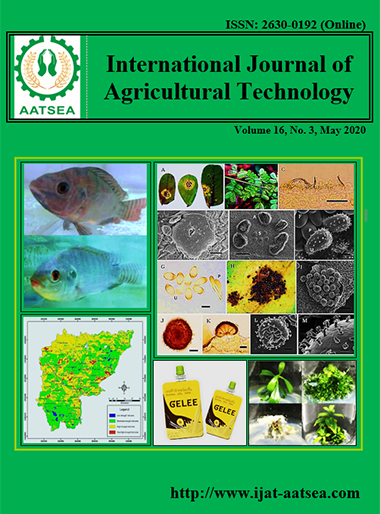Determination of drying behaviour and ethanol production from fresh and dried sweet sorghum stalks
Main Article Content
Abstract
Sweet sorghum, with high photosynthetic efficiency, tolerant to drought and salinity, is rich in sugar and high in biomass which makes it suitable for bioethanol production. However, sweet sorghum is not available throughout the year and stalk can be stored for short period due to high sugar and high moisture content upon harvest. Drying process is known to prolong shelf life of commodity. The drying behaviour of sweet sorghum stalks was determined and ethanol production from sweet sorghum stalks was evaluated. In determining the drying behaviour of the stalks, the predicted shortest drying time using Page equation was 7.99 hours with samples cut into 1-cm chips. The maximum ethanol production was recovered from fresh 10-cm cut samples with cellulase at 221.92 ml per kg dry mass while 168.24 ml of ethanol per kg dry mass was recovered from dried 10-cm stalks. Employing dried and fresh stalk samples for fermentation was proven to be feasible. The fermentation process can be further improved by sugar extraction through agitation and addition of cellulase.
Article Details

This work is licensed under a Creative Commons Attribution-NonCommercial-NoDerivatives 4.0 International License.
References
Matsakas, L. and Christakopoulos, P. (2013). Optimization of ethanol production from high dry matter liquefied dry sweet sorghum stalk. Biomass and Bioenergy, 51:91-98.
Mercer, D. G., Rennie, T. J. and Tubeileh, A. (2011). Drying studies of sorghum for forage and biomass production. Procedia Food Science, 1:655-661.
Reddy, B. V. S., Layaoen, H., Dar, W. D., Srinivasa, Rao, P. and Eusebio, J. E. (2011). Sweet Sorghum in the Philippines: Status and Future. Patancheru 502 324, Andhra Pradesh, India: International Crops Research Institute for the Semi-Arid Tropics.
Shen, F., Peng, L., Zhang, Y., Wu, J., Zhang, X., Yang, G., Peng, H., Qi, H. and Deng, S. (2011). Thin-layer drying kinetics and quality changes of sweet sorghum stalk for ethanol production as affected by drying temperature. Industrial Crops and Products, 34: 1588-1594.
Sutton, K. T. (2011). A Novozymes short report: fermentation inhibitors. Retrieved from http://bioenergy.novozymes.com/.
Wortmann, C. S. and Regassa, T. (2011). Sweet Sorghum as a Bioenergy Crop for the US Great Plains, Economic Effects of Biofuel Production. Retrieved from http://www.intechopen.com/books/.
Yadollahinia, A. R., Omid, M. and Rafiee, S. (2008). Design and fabrication of experimental dryer for studying agricultural products. International Journal of Agricultural and Biology, 10:61-65.
Zhao, Y. L., Steinberger, Y., Shi, M., Han, L. P. and Xie, G. H. (2012). Changes in stem composition and harvested produce of sweet sorghum during the period from maturity to a sequence of delayed harvest dates. Biomass and Bioenergy, 39:261-273.


